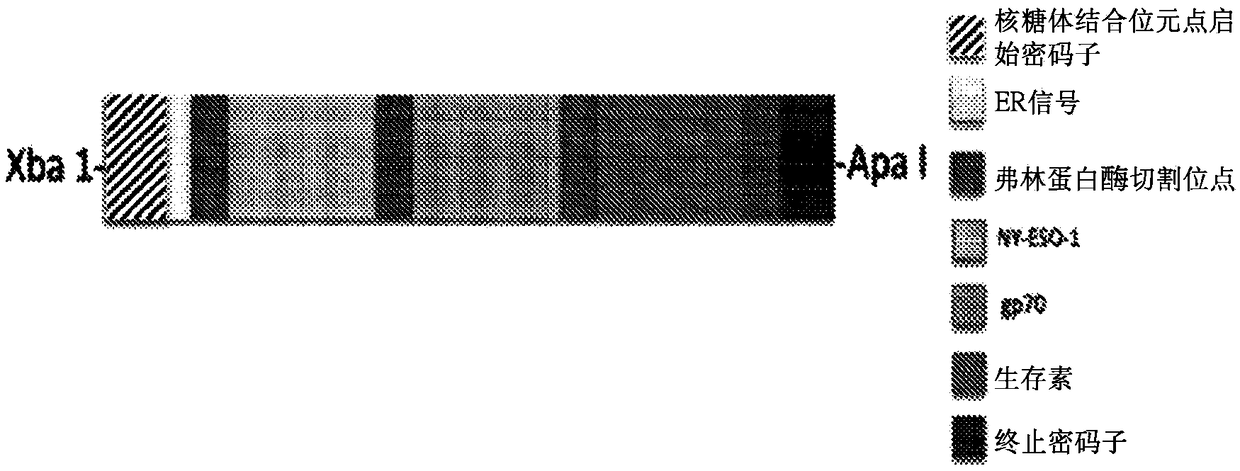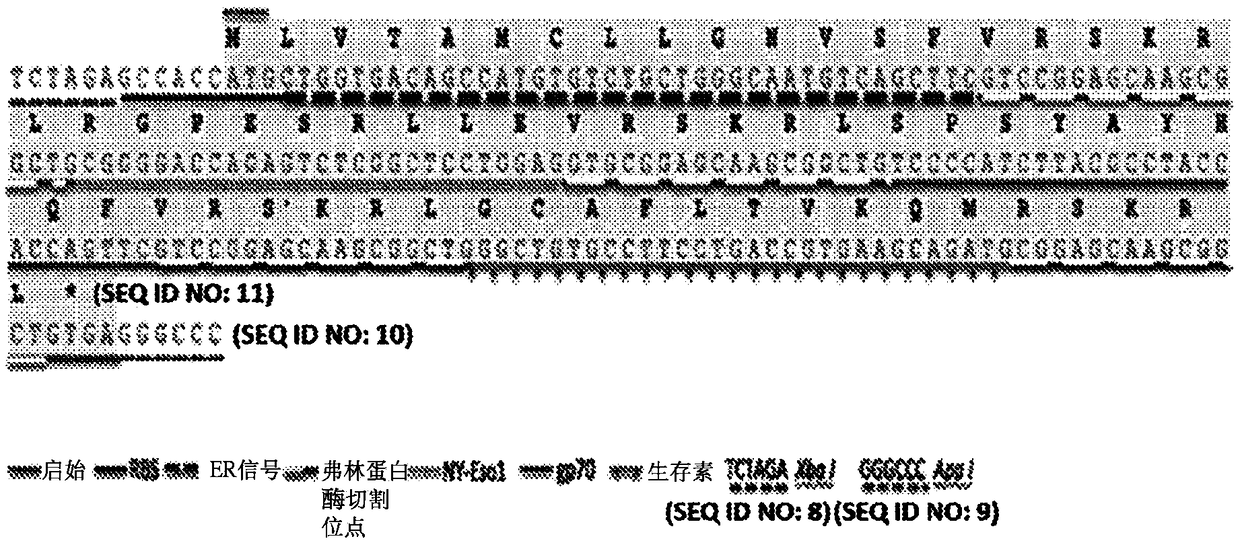Virus vectors expressing multiple epitopes of tumor associated antigens for inducing antitumor immunity
A technology of tumor-related antigens and epitopes, applied in the field of cases, can solve the problem of inability to effectively target viruses
- Summary
- Abstract
- Description
- Claims
- Application Information
AI Technical Summary
Problems solved by technology
Method used
Image
Examples
Embodiment
[0282] Example 1 - Method
[0283] Vector Preparation: Construction of recombinant viral vectors is carried out using standard techniques well known to those of ordinary skill in the field of molecular biology, including but not limited to plasmid purification, restriction enzyme digestion, ligation, transformation, polymerase chain reaction, and DNA Sequencing (for example, Current Protocols in Molecular Biology, EM. Ausubel et al. (Eds), John Wiley and Sons, Inc., NY, USA. (1998) and Molecular Cloning: A Laboratory Manual (2nd Ed.), J.Sambrook, E.F. Fritsch and T. Maniatis (Eds), Cold Spring Harbor Laboratory Press, NY, USA. (1989)).
[0284] For experiments using Sindbis virus vectors encoding LacZ (SV / LacZ) as immunogenic SV / TAA agents, and SV / Fluc and SV / GFP as control vectors, vectors were prepared as previously described. (Tseng J.C. et al., 2004, Nat. Biotechnol., 22:70-77). Briefly, plasmids carrying replicons (SinRep5-LacZ, SinRep5-GFP, or SinRep5-Fluc) or DHBB hel...
Embodiment 2
[0289] Example 2 - Construction of Sindbis virus mediator expressing multiple epitopes to induce anti-tumor immunity
[0290] Polynucleotides (DNA sequences; minigenes) encoding multiple T cell recognition epitopes separated by furin cleavage sites were synthesized by GeneArt (Life Technologies Corp., Waltham MA) using standard molecular biology methods. Synthetic polynucleotides contain a ribosome binding site, a translation initiation codon, an endoplasmic reticulum signal sequence, followed by a furin cleavage site interspersed with epitope coding sequences, a stop codon, and a polynucleotide sequence allowing insertion The XbaI / ApaI restriction endonuclease site (WO 2015 / 035213A2) of the Sindworth replicon pT7StuI-RLacZ#202 was used to replace the restriction enzyme site of the LacZ gene. The Hindworth replicon contains the viral subgenomic promoter sequence upstream of the XbaI site and the mRNA polyadenylation sequence downstream of the ApaI site. The synthetic DNA sequ...
Embodiment 3
[0317] Example 3 - Sindbis virus mediators encoding multiple epitopes of tumor-associated antigens produce polyepitopic mRNA
[0318] Experiments were performed to determine whether the Sindbis virus vector (SV MG-CT26) encoding multiple epitopes of tumor-associated antigens (i.e., NY-ESO-1, gp70 and survivin as described above in Example 2), produced correct polyepitopic mRNA. For the experiment, a 10-fold serial dilution of a Sindbis virus vector encoding multiple epitopes (referred to herein as "SV / MG-CT.26" (100 to 10 -11 )) to infect 2×10 4 Kidney cells of a baby hamster. After overnight culture, cells were harvested by centrifugation and RNA was isolated using a Qiagen kit (Qiagen, Hilden, Germany) according to the manufacturer's instructions. RNA was quantified using a nanodrop spectrophotometer.
[0319] One microgram (1 μg) of each sample was reverse transcribed using ThermoScript (Life Technologies, CA) according to the manufacturer's instructions. The cDNA5_R r...
PUM
| Property | Measurement | Unit |
|---|---|---|
| diameter | aaaaa | aaaaa |
Abstract
Description
Claims
Application Information
 Login to View More
Login to View More - R&D
- Intellectual Property
- Life Sciences
- Materials
- Tech Scout
- Unparalleled Data Quality
- Higher Quality Content
- 60% Fewer Hallucinations
Browse by: Latest US Patents, China's latest patents, Technical Efficacy Thesaurus, Application Domain, Technology Topic, Popular Technical Reports.
© 2025 PatSnap. All rights reserved.Legal|Privacy policy|Modern Slavery Act Transparency Statement|Sitemap|About US| Contact US: help@patsnap.com



